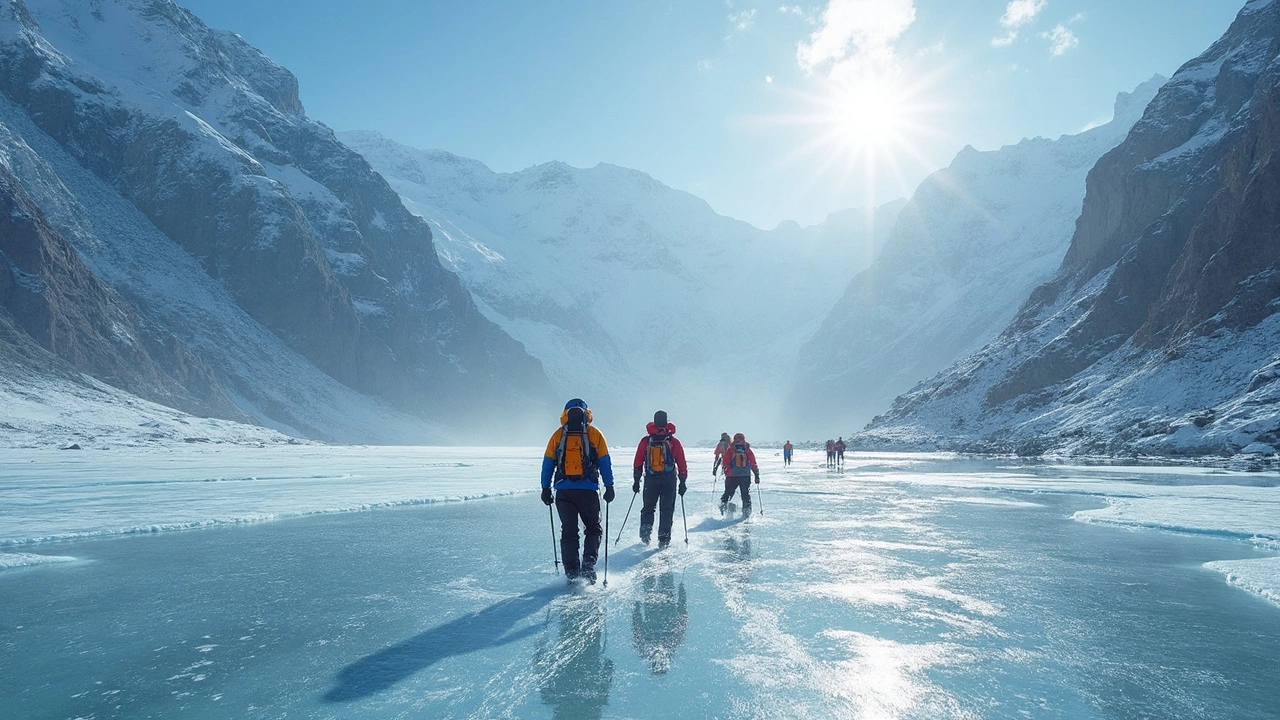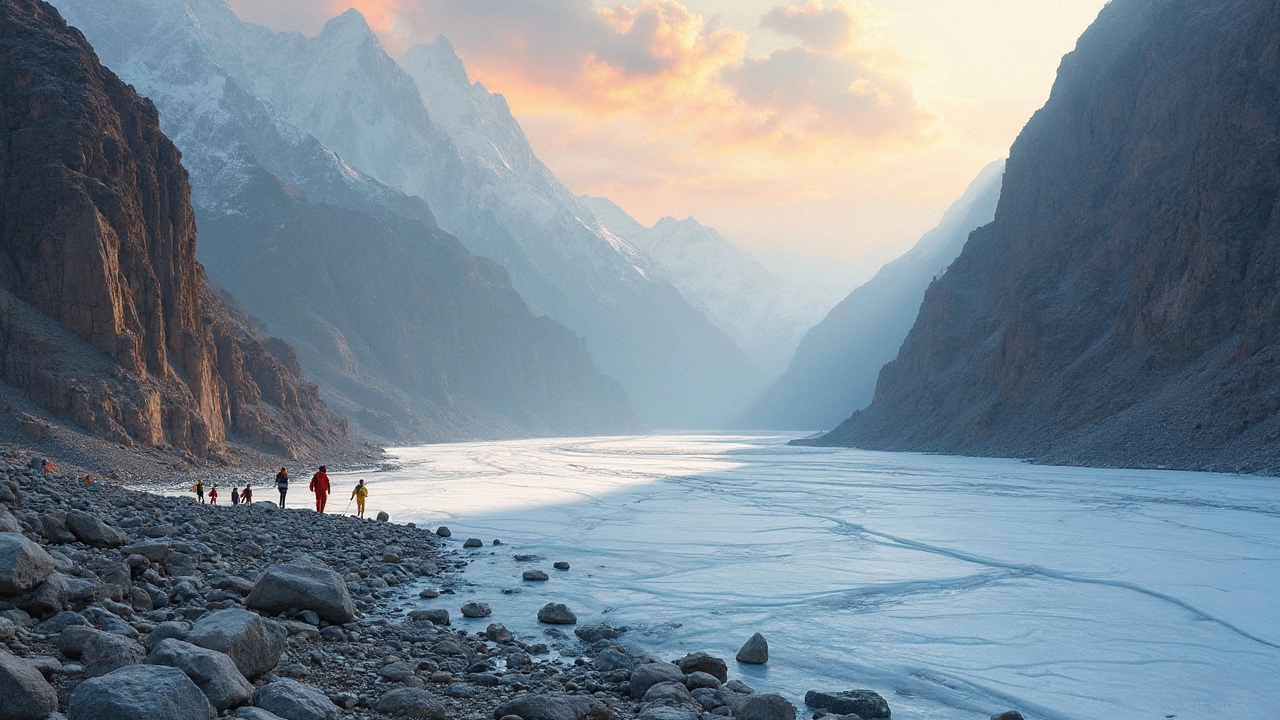The Toughest Trek in India: Conquering the Chadar Trek

- Feb, 16 2025
- 0 Comments
- Aaron Blackwood
When it comes to trekking in India, few treks can match the reputation of the Chadar Trek. Named after the blanket of ice it traverses, this trek in Ladakh definitely tops the list of difficult treks. It's not your average walk in the park; think sub-zero temperatures, slippery paths, and an enchanting frozen river.
What makes Chadar Trek challenging? For starters, it's a test of endurance. Temperatures can plummet to around -30 degrees Celsius at night. Trekkers have to walk on a sheet of ice covering the Zanskar River, and the landscape can change dramatically overnight due to shifting ice. It's an adventure that requires serious commitment and preparation.
- Introduction to Chadar Trek
- Why It's Considered Difficult
- Preparation Tips
- Safety Measures and Survival Skills
- Experiencing the Trek
Introduction to Chadar Trek
The Chadar Trek is not just another trek; it's a surreal journey through one of the most remote areas of the Himalayas. Located in the region of Ladakh, the trek covers around 62 miles (100 km) and usually stretches over a period of 9 days, taking adventurers along the frozen Zanskar River.
The trek usually happens between January and February when the winter is at its peak and the river is frozen solid. But why do people endure temperatures that can drop to -30°C? Because the views are nothing short of otherworldly. The ice formations, the stark, pristine beauty of the ice-covered river, and the towering cliffs surrounding you make it an unmissable experience.
The Frozen Journey
Each day on the Chadar Trek is unique, with landscapes transforming due to temperature fluctuations. Warm days can melt the top layer of the ice, while a sudden cold spell overnight can reshape the surface, creating an ever-changing path to tread.
The trek begins at Chilling, a small village in Ladakh, and ends in the village of Nerak. Along the way, trekkers stay overnight in caves and tents set up on the riverbanks. There's nothing quite like waking up to the silence and serenity blanketed by the Himalayan landscape.
Historical Context
Historically, the frozen Zanskar river has been used as a route by locals for centuries. When the passes in the region are closed due to heavy snowfall, the Chadar or 'blanket' of ice provides a lifeline, connecting villages for trade and social exchange. For trekkers, it's a chance to walk in the footsteps of history while experiencing the ultimate test of physical and mental strength.
Why It's Considered Difficult
Tackling the Chadar Trek isn't for the faint-hearted. This demanding journey is defined by its oppressive cold and unpredictable terrain, challenging even the most seasoned trekkers. Here's a closer look at what makes this trek a real test of endurance.
Harsh Weather Conditions
The Chadar Trek demands that trekkers face extreme weather. During the day, temperatures hover around -10 degrees Celsius, while night plummets further to a brutal -30 degrees. Staying warm is crucial, yet staying mobile wearing layers upon layers poses its own challenges.
Unpredictable Ice Conditions
This trek involves walking on a sheet of ice that forms over the frozen Zanskar River. Each day can bring a completely different trail, as the ice shifts and cracks. Trekkers must adapt quickly to changing conditions and tread carefully to manage these tricky surfaces.
Remote Location
Set in the remote region of Ladakh, getting to the start of the trek itself is no small feat. The isolation means limited access to medical and support facilities, pressing home the need for physical fitness and preparation.
Altitude Challenges
At an average altitude of 11,000 feet, altitude sickness is a genuine risk. Understanding how to acclimatize properly can make all the difference in successfully completing the Himalayan treks. It's not just about pace; it's about listening to your body.
For those determined to conquer one of the most difficult treks in India, proper preparation and awareness of these conditions are vital. It’s no walk in the park, but the reward of witnessing such breathtaking beauty firsthand is well worth the effort.

Preparation Tips
Getting ready for the Chadar Trek isn’t just about packing your bags and heading out. It requires thorough preparation to handle the chilling conditions and challenging terrain. Here’s how to gear up for this unique adventure:
Physical Fitness
Before you even think about setting foot on the frozen Zanskar River, start building your stamina. Consistent cardio workouts like jogging, swimming, or cycling can help increase your overall endurance. Strong legs and a sturdy core from strength training will be your best friends when you're on the icy paths.
Acclimatization
Ladakh’s high altitude can catch many off guard, so acclimatization is crucial. Spend a couple of days in Leh before starting the trek. This gives your body the necessary time to adjust to the thin air, reducing the risk of altitude sickness.
Gear Up Properly
You’ll want to pack smart. Think thermal wear to stay warm, high-quality trekking boots with good grip, and moisture-wicking layers. Don't forget essentials like a sturdy backpack, trekking poles, and a reliable sleeping bag rated for cold conditions. Your gear can make or break the trek.
- Thermal Clothing: Invest in good thermal inner wear and windproof jackets.
- Footwear: Solid trekking shoes with excellent grip and waterproof quality.
- Navigation Tools: Maps, compass, or a reliable GPS device.
Diet and Hydration
Winter treks can deplete your body's energy stores quickly. A balanced diet rich in proteins and carbs will keep you fueled. Stay hydrated even when it’s cold; carry a thermos for warm drinks. Remember, sustaining energy is key to surviving the cold.
Knowledge and Mental Prep
Being mentally prepared is as important as physical training. Educate yourself about the trek, understand the challenges, and know how to handle emergencies. Sometimes mental toughness plays a bigger role than physical strength.
Emergency Planning
Having an emergency plan is crucial. Ensure your travel insurance covers high-altitude trekking and harsh weather. Share your itinerary with friends or family and keep a list of emergency contacts handy. It’s always better to be safe than sorry.
Follow these tips, and you'll be better prepared to tackle the incredible yet demanding journey that the Chadar Trek offers. Safe trekking!
Safety Measures and Survival Skills
Tackling the Chadar Trek is as much about preparation and survival as it is about adventure. With the extreme cold and unpredictable ice conditions, it's vital to be equipped with the right safety measures. Let’s dive into some essential tips to keep in mind.
Proper Clothing
Layering is key. You'll want a solid base layer to wick away moisture, a middle layer for insulation, and an outer layer that's waterproof and windproof. Pay attention to your feet and hands, as these are prone to frostbite. Invest in good quality thermal socks and insulated gloves.
Navigation and Group Travel
The trek leads through remote and icy terrains. Travel with a trusted guide who knows the region well. Always trek with a group to ensure mutual support in case someone needs help. Carry a map and a GPS device as part of your navigation toolkit.
Health and Acclimatization
Give your body time to adjust to the altitude in Ladakh before heading out. Spend a couple of days at Leh to acclimatize. Avoid alcohol and stay hydrated to prevent altitude sickness. Carry a basic first-aid kit with necessary medications, especially for altitude sickness.
Emergency Preparedness
In case of an emergency, be aware of your nearest exit points and emergency contacts. Satellite phones can come in handy when there's no cell service.
Food and Nutrition
Keep energy levels high with nutritious snacks like nuts and energy bars. Meals should be simple yet calorie-dense to keep you warm and energized.
Equipment Essentials
- Good quality hiking boots with strong grip
- Walking poles for stability on ice
- Sleeping bags rated for extreme cold
- Headlamps with extra batteries
- Insulated water bottles to prevent freezing
Remember, the Chadar Trek is an unforgettable experience, but safety should never be compromised. Equip yourself with the right gear, follow expert advice, and respect the harsh yet beautiful nature of the frozen Zanskar River.

Experiencing the Trek
Embarking on the Chadar Trek is like stepping into another world. The journey begins with a flight to Leh, nestled in the mountains of Ladakh, a region known for its dramatic landscapes. As you acclimate to the altitude, you can't help but feel the anticipation of the adventure that lies ahead.
Day-to-Day Trekking
The trek spans approximately 9 days, and each day brings a new challenge and breathtaking beauty. During the day, trekkers cover around 10-15 kilometers on average. The trail varies from smooth ice to rocky terrains and, at times, open patches of swirling water.
The highlight of each day? Spectacular sights. Whether it's towering cliffs hugging the river or the sound of ice cracking underfoot, nature's raw beauty is both humbling and awe-inspiring. At night, trekkers camp in caves or set up tents on the riverbank, sharing stories around bonfires as the frigid air presses close.
Challenges and Rewards
Yes, it's tough. The cold can bite hard, and the trail demands focus and respect. But for every wobble on the ice, there's triumph in staying upright and every chilly night brings the reward of a star-laden sky that's unlike anything you've ever seen.
Unforgettable Moments
- Sitting by the river at Nerak waterfall, a frozen marvel that leaves you astounded by nature's artistry.
- Spotting elusive mountain wildlife like the snow leopard or blue sheep along the journey.
- Witnessing the changing colors of the ice and the play of light across the landscape, each shift in weather painting a new masterpiece.
Knowing the Terrain
Trekkers should keep in mind that the Chadar Trek is heavily weather-dependent. An unexpected thaw can halt the journey, underscoring the importance of flexibility in planning your trek.
Equipped with grit, a sense of adventure, and a decent guide, experiencing the Chadar Trek can be a truly transformative journey, etching memories that last a lifetime.